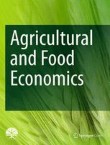Sustainability challenges in the multi-tier crop agri-food sector: a systematic review
This systematic review identifies the potential sustainability challenges lower-tier suppliers and buying firms face in multi-tier crop agri-food supply chains. The first stage applied systematic mapping, and ...


